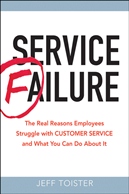Old but good service concept: the Circle of Influence
 Jeff Toister
Jeff Toister  Wednesday, November 25, 2009 at 8:29AM |
Wednesday, November 25, 2009 at 8:29AM | One of my favorite customer service concepts is the "Circle of Influence". It reminds us that there are things we cannot control, such as our customers, so we should focus on things we can control (like our reaction to our customers).

A story...
My phone rang and I answered it, "Hello, this is Jeff." The person on the other end was a colleague that I had met a few times, but didn't know well. "Hi Jeff, do you have a minute?" she asked.
"Sure," I said.
Silence. Then... "Are you sure you have a minute? You sounded really hesitant. I can call back if this isn't a good time."
Huh?! It took a second to collect my thoughts. "I don't know why you think I sounded hesitant. I said sure. How can I help you?"
Again, awkward silence. Then... "Hey, I didn't mean to cause any conflict or upset you in any way. I'm just calling to ask you for a phone number, but if this isn't a good time or you don't want to give me the number that's OK, just say so. I'm really not trying to cause any problems."
I gave her the phone number, but I couldn't get off the phone fast enough. That lady was nuts!!
It took me a few minutes afterwards to get over it, but then I reminded myself about the circle of influence. I really felt she was pushing my buttons, but I also realized I had allowed my buttons to be pushed. There was a good chance I'd run into this person again, so I wanted to be sure I was better prepared the next time. Looking at my "circle of influence" I realized what the crucial piece of dialogue should have been.
Crazy Lady: "Hi Jeff, do you have a minute?"
Me: "Sure."
Crazy Lady: "Are you sure you have a minute? You sounded really hesitant. I can call back if this isn't a good time."
Me: "I'd be happy to speak with you now. How may I help you?"
Epilogue
This little exercise really paid off. I saw Crazy Lady a couple weeks later. This time there were other people present, so there would be witnesses if I didn't handle it well. Sure enough, she stayed in character and said something crazy and provoking, a classic "button pushing" move. Fortunately, I remembered my little circle of influence self-pep talk and I was ready. I just smiled, shrugged it off, and redirected the conversation to keep it positive. Awkward conflict avoided!



